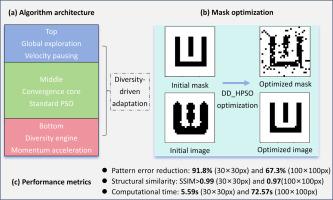Dynamic diversity-driven hierarchical particle swarm optimization method for edge distortion compensation in digital lithography mask optimization
IF 3.7
2区 工程技术
Q2 OPTICS
引用次数: 0
Abstract
Digital micromirror device (DMD) lithography suffers from edge distortions caused by micromirror discretization and diffraction effects. To address this challenge, this study proposed a diversity-driven hierarchical particle swarm optimization (PSO) method for high-fidelity mask optimization. The algorithm integrated tri-level population dynamics with adaptive diversity control to overcome premature convergence. Validation on CEC2005 and CEC2022 benchmarks demonstrated exceptional accuracy, including near-zero errors on multimodal functions. For 30*30 test patterns masks, pattern error (PE) reduced 91.8% with structural similarity index measure (SSIM) exceeding 0.99 at 5.59 s average runtime. For 100*100 complex masks, PE decreased 67.3% with SSIM above 0.97 at 72.57 s average runtime. This framework provided an efficient and effective solution for achieving high quality image in digital lithography.

数字光刻掩模优化中边缘畸变补偿的动态分集驱动分层粒子群优化方法
数字微镜器件(DMD)光刻存在微镜离散和衍射效应引起的边缘畸变。为了解决这一挑战,本研究提出了一种多样性驱动的分层粒子群优化(PSO)方法用于高保真掩模优化。该算法将三层种群动态与自适应多样性控制相结合,克服了早熟收敛问题。在CEC2005和CEC2022基准上的验证证明了卓越的准确性,包括在多模态函数上接近零的误差。对于30*30个测试模式掩模,在5.59 s的平均运行时间下,模式误差(PE)降低了91.8%,结构相似指数(SSIM)超过0.99。对于100*100的复合掩模,平均运行时间为72.57 s, PE降低67.3%,SSIM高于0.97。该框架为实现高质量的数字光刻图像提供了高效的解决方案。
本文章由计算机程序翻译,如有差异,请以英文原文为准。
求助全文
约1分钟内获得全文
求助全文
来源期刊

Optics and Lasers in Engineering
工程技术-光学
CiteScore
8.90
自引率
8.70%
发文量
384
审稿时长
42 days
期刊介绍:
Optics and Lasers in Engineering aims at providing an international forum for the interchange of information on the development of optical techniques and laser technology in engineering. Emphasis is placed on contributions targeted at the practical use of methods and devices, the development and enhancement of solutions and new theoretical concepts for experimental methods.
Optics and Lasers in Engineering reflects the main areas in which optical methods are being used and developed for an engineering environment. Manuscripts should offer clear evidence of novelty and significance. Papers focusing on parameter optimization or computational issues are not suitable. Similarly, papers focussed on an application rather than the optical method fall outside the journal''s scope. The scope of the journal is defined to include the following:
-Optical Metrology-
Optical Methods for 3D visualization and virtual engineering-
Optical Techniques for Microsystems-
Imaging, Microscopy and Adaptive Optics-
Computational Imaging-
Laser methods in manufacturing-
Integrated optical and photonic sensors-
Optics and Photonics in Life Science-
Hyperspectral and spectroscopic methods-
Infrared and Terahertz techniques
 求助内容:
求助内容: 应助结果提醒方式:
应助结果提醒方式:


